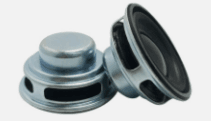
Micro Speaker Component
micro speakers are tiny loudspeakers designed for products with small diameter requirements.This micro speaker delivers clear, powerful sound quality, perfect for mobile devices, wearables, and compact audio systems

Loudspeaker
Loudspeaker is composed of lightweight material like paper, plastic, or composite materials.The shapes of speakers is square or round .Loudspeaker Capable of handling full-range frequencies and sound, this speaker ensures balanced audio across all levels for a dynamic listening experience.

Mylar Speaker
The Mylar speaker, made of a plastic cone, is moisture, water-resistant, and highly consistent. Our Mylar Speaker solutions come in a variety of shapes and sizes. Rectangular-, square-, oval-, or round-frame package options

Multimedia Cavity Speaker
The design of the cavity speaker is very sophisticated. It usually consists of a resonance chamber and a speaker unit. The design of the resonance chamber allows the sound to be reflected and diffused inside, thereby increasing the volume and sound quality.

Transparent Mylar Speaker
Made from durable, transparent Mylar, this speaker offers a unique look while delivering clear, powerful audio. The Mylar diaphragm allows for accurate sound reproduction across a wide frequency range, ensuring balanced bass, mids, and treble for a superior listening experience.

Multimedia Round Loudspeaker
The multimedia round loudspeaker is composed of lightwight material like PU, paper, or other material. The shape of speaker is round. The multimedia round loudspeaker generally uses an internal magnet structure.The round multimedia speaker allows accurate sound reproduction across a wide frequency range
What is micro speaker
A speaker is an electro-acoustic transducer that transforms an audio signal into a corresponding sound. micro speakers are tiny loudspeakers designed for products with small diameter requirements
Micro speakers are miniaturized electronic components commonly found in mobile devices, headphones, and audio products. They can convert electrical signals into air vibrations to produce sound. Due to their small size, low power consumption, and good sound quality, they are widely used in various fields.
micro speakers feature a small footprint and low profile. When space is limited, we produce micro speaker component have a low profile design with small dimensions and are fitted with either mylar or paper cones. They often require an external drive circuit to operate.
The micro speaker adopts thin design and is equipped with polyester film cone to improve durability , The speaker adopts thin design and is equipped with polyester film cone to improve durability , making it very suitable for smart phones, tablets, laptops, automotive electronics and Bluetooth headsets. Several TV laptop speaker or micro speaker for mobile phone models also have an inlet protection (IP) rating of IP67 for applications dealing with moisture and environmental pollutants.

Active Electro-magnetic Buzzer
Magnetic Active buzzer usually adopts a split structure and has the advantages of loud sound, wide frequency range, and light weight. Magnetic Active buzzers are called active because they only need a DC voltage to produce sound. Passive buzzers need an AC voltage to produce sound.

Passive Electro-Magnetic Buzzer
Electromagnetic buzzers work on the principle of electromagnetic induction. They are mainly composed of a coil and a magnet. When current passes through the coil, a magnetic field is generated, which interacts with the magnet to make the buzzer sound. This type of buzzer usually adopts a split structure and has the advantages of loud sound, wide frequency range, and light weight.

passive piezoelectric buzzer
Piezoelectric passive buzzer usually adopts an integrated structure and has the advantages of stable frequency, beautiful tone, small size, light weight, and low power consumption.The advantages of passive buzzers are that they are relatively cheap and the sound frequency is controllable, which can achieve the basic seven-note effect in music. However, since they require additional drive circuits, they are relatively complicated to use.

Piezoelectric active buzzer
The Piezoelectric buzzer usually adopts an integrated structure and has the advantages of stable frequency, beautiful tone, small size, light weight, and low power consumption.Active piezo buzzers are exactly as they might sound. Supplying 3.3V or 5.5V to the positive lead of the active piezo buzzer will cause the piezo to start emitting an audible buzz. The active piezo has an internal oscillator

Mechanical Buzzer
Mechanical buzzers use electromagnetic effects to make current flow through the coil repeatedly, generate an alternating magnetic field, and absorb and release the vibrating plate to form high-frequency vibrations, thereby generating sound. Specifically, after adding a sufficient magnetic field to the vibrating plate, the vibrating plate will produce a small displacement under the action of electromagnetic force, and form sound.

SMD Buzzer
The electromagnetic patch buzzer is small in size, light in weight, easy to install, woven packaging, and convenient for transportation. Its advantages are low voltage and high sound pressure. It can usually reach 85db at 1.5V, which can make the response frequency of the electromagnetic buzzer very low
What is buzzer ?
The buzzer is an electronic component that produces a continuous and sharp sound signal. It is usually composed of a diaphragm, a vibration source, and a driving circuit. It is mainly used to issue alarms, reminders, or prompts.
1. Alarm and warning: Buzzers are often used in alarm systems, security systems and fire alarms. When the equipment detects an abnormal or dangerous situation, it will emit a sharp sound to alert people.
2. Prompt and remind: In some electronic equipment, buzzers are used to provide prompts or reminders, such as the “beep” sound emitted by a microwave oven when it finishes heating.
3. Indication and signal: Buzzers can also be used as sound sources for device status indication or signal transmission, such as prompt sound effects in electronic games.
4. Communication and interaction: In some electronic devices, buzzers can be used to interact with users through sound, such as electronic doorbells, alarm clocks, etc.
5. Fault prompt: The buzzer in some devices is also used to indicate the device fault or error state, prompting the user to perform inspection or maintenance.
